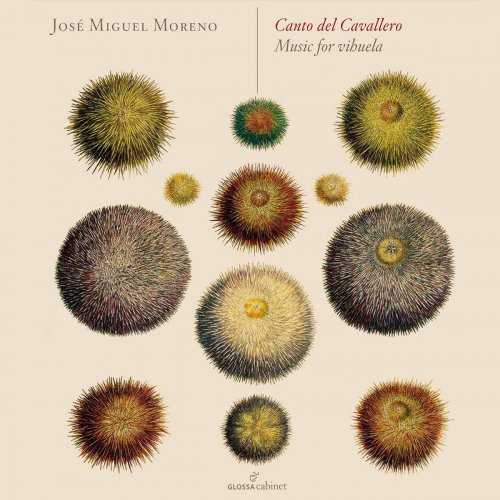
Jose Miguel Moreno - Canto del cavallero: Music for Vihuela (2020)
BAND/ARTIST: Jose Miguel Moreno
- Title: Canto del cavallero: Music for Vihuela
- Year Of Release: 2020
- Label: Glossa
- Genre: Classical
- Quality: FLAC (tracks)
- Total Time: 72:48 min
- Total Size: 242 MB
- WebSite: Album Preview
Tracklist:
01. Cinco diferencias sobre las vacas (Version for Vihuela)
02. Pues no me quieres hablar (Version for Vihuela)
03. Cinco diferencias sobre "Conde Claros" (Version for Vihuela)
04. Pavana con su glosa "La cara cosa" (Version for Vihuela)
05. Glosa sobre tan que vivray
06. Fantasia No. 51 "De redobles"
07. Con qué la lavaré
08. De Antequera sale el moro
09. Morenica dame un beso
10. Dezilde al cavallero que
11. Madona mala vostra
12. La cortesía
13. Pavana muy llana para tañer
14. Diferencias sobre "La dama le demanda" (Arr. for Vihuela)
15. Diferencias sobre "El canto del caballero" (Arr. for Vihuela)
16. Soneto No. 22 "Lo que queda es lo seguro"
17. Soneto No. 27
18. Soneto No. 8
19. Canción No. 7 "A mi sufle"
20. Fantasía No. 8
21. Fantasía No. 12
22. Fantasía No. 1
23. Quie amores ten
24. Falai mina amor
25. Fantasía No. 11
26. Pavana No. 4
27. Pavana No. 5
28. Diferencias sobre las vacas
01. Cinco diferencias sobre las vacas (Version for Vihuela)
02. Pues no me quieres hablar (Version for Vihuela)
03. Cinco diferencias sobre "Conde Claros" (Version for Vihuela)
04. Pavana con su glosa "La cara cosa" (Version for Vihuela)
05. Glosa sobre tan que vivray
06. Fantasia No. 51 "De redobles"
07. Con qué la lavaré
08. De Antequera sale el moro
09. Morenica dame un beso
10. Dezilde al cavallero que
11. Madona mala vostra
12. La cortesía
13. Pavana muy llana para tañer
14. Diferencias sobre "La dama le demanda" (Arr. for Vihuela)
15. Diferencias sobre "El canto del caballero" (Arr. for Vihuela)
16. Soneto No. 22 "Lo que queda es lo seguro"
17. Soneto No. 27
18. Soneto No. 8
19. Canción No. 7 "A mi sufle"
20. Fantasía No. 8
21. Fantasía No. 12
22. Fantasía No. 1
23. Quie amores ten
24. Falai mina amor
25. Fantasía No. 11
26. Pavana No. 4
27. Pavana No. 5
28. Diferencias sobre las vacas
The repertory of the Spanish vihuela from the 16th century remains little investigated, partly because few original instruments exist; when vihuela works appear on recordings they are often played on the lute or guitar. This is a shame, for the instrument has its own sound and a repertory (albeit one that often claimed playability on various instruments) that exploited that sound. The vihuela is large, with six pairs of strings running up a large body and long neck, and the music on this album exploits the instrument's rich sonority and capability for ornamentation rather than the rapid runs, called redobles in Spanish, that are characteristic of music for other plucked stringed instruments. This album was issued in 1992 on the Glossa label; beautifully recorded, it still had little competition when reissued in 2010. Six composers are represented, most of them quite obscure: Luys Venegas de Henestrosa, Miguel de Fuenllana, Diego Pisador, Antonio de Cabezón, Enríquez de Valderrábano, and Luys Milán, and there is one anonymous set of diferencias (variations). The genre situation is fluid in this repertory (for instance, there's some evidence that any work not based on a preexisting vocal model might be considered a "fantasía"), but generally speaking there are three basic types: intabulations of vocal pieces, which might involve elaboration and be called a "glosa" or gloss; diferencias; and dance pieces, often on Italian lute models. The glosas are fancier and more ornamented than you might think; sample Fuenllana's Glosa sobre Tan que vivray (Claudin de Sermisy's Tant que vivray, track 5, for a piece based on a familiar Renaissance song). The diferencias, on the other hand, are reflective and subtle rather than fiery, except for the Cabezón pieces, which were keyboard works, and, though theoretically suited to the vihuela, too, take some doing to play this way. For the casual listener it's a lot of vihuela, but ornamentation and the occasional pungent harmonic detail provide variety. The engineering remains a major strong point; recorded in the Villa Consuelo in the Spanish town of San Lorenzo del Escorial, the vihuela is in an environment close to the ones where the music was originally heard, and it is clear and immdiate without being overbearing. A worthwhile release, especially for those with an interest in this and similar repertories.
Year 2020 | Classical | FLAC / APE
As a ISRA.CLOUD's PREMIUM member you will have the following benefits:
- Unlimited high speed downloads
- Download directly without waiting time
- Unlimited parallel downloads
- Support for download accelerators
- No advertising
- Resume broken downloads


